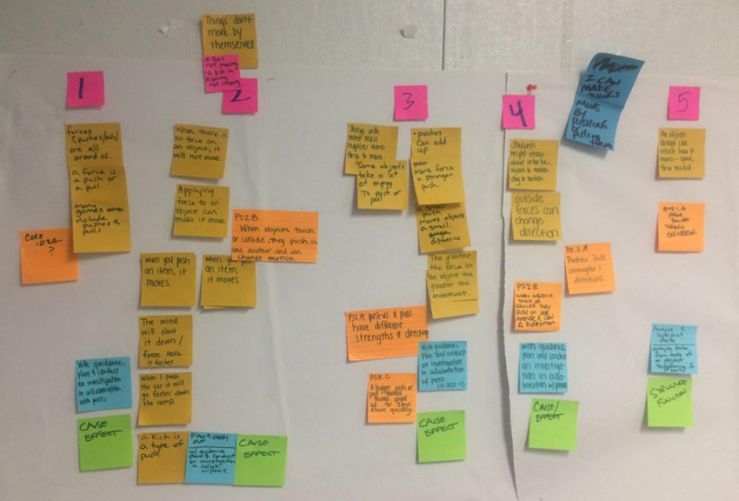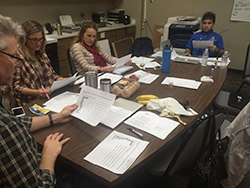NGSS and the Teaching Learning Collaborative: It’s About the Process
By Dave Tupper and the CA NGSS K-8 Early Implementation Initiative Core Leadership Team at Lakeside Union School District
Change is a process, not an event!
The CA Next Generation Science Standards (CA NGSS) require significant instructional and conceptual shifts in terms of how science instruction is planned, delivered, and assessed (NGSS Lead States, 2013). With several California Math Science Partnership (CaMSP) Grants under our belt, and now as a district partner in the CA NGSS K-8 Early Implementation Initiative, the Lakeside Union School District is able to provide some perspective related to helping teachers as they address those shifts.

Conceptual Flow built from TLC Planning Day
We learned that one of the most powerful professional learning strategies in assisting teachers as they become more facile with the NGSS and the requisite shifts continues to be the Teaching Learning Collaborative (TLC) (K-12 Alliance, 2017). In a nutshell, the TLC is a multi-day lesson study model in which teams of 3-4 teachers, guided by a facilitator (a trained K-12 Alliance Regional or Project Director or member of our Core Leadership Team), spend a full day collaboratively building a phenomenon-based, Three-Dimensional Conceptual Flow for a sequence of instruction, Three-Dimensional includes Disciplinary Core Ideas (DCIs), Science and Engineering Practices (SEPs), and Crosscutting Concepts (CCCs). From the Conceptual Flow, the team selects a “chunk” to flesh out and develop into a 5E Learning Sequence complete with teacher prompts expected student responses and built-in decision point assessments. It is rigorous but rewarding work that involves really digging into the NGSS, negotiating ideas, and thinking hard about what kids are asked to do when they are asked to do it, and how they will demonstrate their understanding using DCIs, SEPs, and CCCs to help students explain phenomena or solve a problem.
On the TLC Teaching Day, using a script for the lesson, the team co-teaches the learning sequence they designed. It should be noted that in this lesson study model, one teacher is “on” at a time, thus taking the onus off of the teacher who is teaching, and making the focus more on the lesson design. Teaching is followed by a debrief of the effectiveness of the design that is supported by evidence from the facilitator scripting notes and student work collected during the lesson. Teams analyze the notes and student work for indicators of how well the lesson design resulted in the desired student understanding. The learning sequence is then redesigned based on this evidence and taught to another group of students. The process of looking at student work is repeated and the learning sequence is refined in the following pattern: plan, teach, debrief; adjust, teach, debrief.

Lakeside Union School District Concerns-Based Adoption Model
While the TLC process is one of the most effective professional learning strategies we have encountered, it is not without a learning curve. As budding leaders and facilitators of the TLC process, the Lakeside NGSS Core Teacher Leaders have noticed some patterns in how teachers tend to respond and react to the TLC process over time. These teacher responses are loosely analogous to the Concerns-Based Adoption Model (CBAM) Stages of Concern educators experience as they move through the change process (Hall, G. E., et al, 1987). In Lakeside’s experience, the CBAM Stages of concern seem to fall into three “Clusters of Concern” as teachers’ experience with the TLC process progresses from novice to veteran.
Concerns About Planning
In their first few TLC cycles, teacher concerns/reactions tend to cluster around planning. When unfamiliar with the TLC as a process, teachers often expect a “make and take” lesson, and wonder aloud, “I thought you were giving us some lessons to use in our classroom”; followed shortly by “six hours to plan a lesson! I usually plan my whole science year in that time”; or, “this is great but you know we can’t take so long to plan each of our lessons.” Novice TLC teachers are often less comfortable with the idea of backward planning, especially when it comes to science instruction, and tend to begin their planning around activities rather than identifying the science concepts (DCIs) and elements of SEPs and CCCs we expect students to understand. We hear things like: “I have this cool activity that is super fun, and it is easy”; “why can’t we just google lesson ideas”; “It seems weird to start from scratch when there are already lessons out there.” Concerns about planning also include questions related to management in terms of materials and time, as well as concerns about releasing teacher “control” as the learning becomes more student-centered. All of these questions and concerns are natural and legitimate when learning a new process, and effective facilitators have come to expect them.
It Is About the Student Learning
With only two or three TLCs under their belt, teacher concerns seem to shift from personal concerns about planning to those related to student thinking and how they might adjust instruction and practice to further develop deeper student understanding of the three NGSS dimensions. Teachers come to see the TLC as a strong professional learning experience and their mindset begins to shift. “The design process of the 3-D 5E lesson was different from how I traditionally planned a lesson. Even with UbD training, this process was much easier to think about the flow of the lesson, especially in terms of what the students versus what the teacher is doing. I really feel that this second time around I had a much better understanding of the whole process.”
As teachers gain experience with the TLC process, they begin to focus more on what the students are doing and how they will demonstrate that learning authentically as they move through the stages of a 5E learning sequence. The lesson debriefs, using evidence from the learning experience, provides opportunities to examine student learning on a much deeper level than teachers are generally accustomed to…and they love it. When debriefing the lesson through the lens of this objective evidence, there are some realizations or “aha’s” that surface around the idea of student thinking/learning.
Reviewing the transcript of the lesson leads teachers to make comments like: “I think I talk too much, the kids should be doing more of the talking”; “I gave away all the science, and the kids just repeated it/agreed with me”; “When we revised the lesson to provide more student thinking time, students stepped up to share what they understood”; “I noticed that we (teachers) mostly just asked the students questions, and they did the thinking.”
Examining the student work often brings the realization that their students are often capable of more sophisticated thinking than we give them credit for, and they can do it without walking them lockstep through a procedure. Whether it is a Transitional Kindergarten class that was able to plan and conduct (with guidance) investigations into pushes and pulls on the playground, or a middle school class developing and revising models about the flow of energy within ecosystems, teachers begin to view instruction more through the lens of student thinking rather than task completion. Some common teacher observations include things like: “My kids can do more than I thought when I release some control”; “I see now that my other labs/activities tended to be more standalone or confirmatory, and that limits my students opportunities to think scientifically”; “I learned to question students rather than provide them with an answer. Student thinking is more important than simply completing a task or knowing the ‘correct’ answer.”
Collaboration Is Where It's At

Student Work
After three or four TLC cycles and with planning for student learning more of a “habit of mind” instead of a concern, teachers begin to think about how they can meaningfully collaborate with their colleagues as they seek to spread and sustain the ideas of planning for deeper student understanding, and analyzing authentic student work as they hone their craft. “This process works for any content area”; or “our grade level team has started using parts of this process during our PLC time” are some of the quotes shared by TLC participants. The process of change enters the final CBAM stage as teachers begin to refocus and refine what they have internalized through their TLC experiences and start applying for the work across their practice. It becomes less about individual content areas, and more about effective teaching and learning. “At our site, we do kind of a mini-TLC for different areas”. The common denominator in this stage is collaboration. There are a lot fewer “I” statements and a lot more “we” comments. While they may have the individual will and skill to address the conceptual and instructional shifts expected with the NGSS, it is so much better to move through these adjustments with a few friends.

Lakeside Union School District Concerns-Based Adoption Model
Continuous Improvement
As a professional learning strategy, the TLC process has been an incredibly effective way to help change teacher practice in light of the NGSS shifts. Watching teachers move through the change process as their concerns shift from planning, to student thinking, and to collaboration cements the idea that change is a process and it takes time. This is echoed in the principles of the NRC’s National Framework for K-12 Science Education when they mention: “a focus on core ideas, the development of true understanding over time, the consideration both of knowledge and practice” as being critical to growing in our understanding” (p. 26). After working so closely together for three years, Early Implementer TLC teachers have forged meaningful personal and professional relationships (often across sites) that help to open their practice, allow them to address the NGSS shifts in a safe space, and provide a structure to sustain and disseminate the learning. In short, the TLC process has allowed the district to build a true professional learning community and to develop the leadership capacity to help others embrace the process of change.
For more information on the nuts and bolts of the TLC, check out the companion piece to this article: K-12 Alliance Teaching Learning Collaborative: Nuts and Bolts of a Lesson Study.
Dave Tupper and the CA NGSS K-8 Early Implementation Initiative Core Leadership Team at Lakeside Union School District, Lenny Correia, Lucia González, Aubri McWay, Brian Mendoza, Cecilia Ochoa, Danielle Schniepp, Zulma Santana. All are members of CSTA.
References:
DiRanna, K., Osmundson, E., Topps, J., Barakos, L., Gerhardt, M., Cerwin, K., Carnahan, D., & Strang, C. (2008). Assessment Centered Teaching: A Reflective Practice. Thousand Oaks, CA, Corwin Press.
Hall, G. E., and Hord, S. M. (1987). Change in schools: Facilitating the process. Albany, NY: State University of New York Press.
K-12 Alliance at WestEd. (2017). Teaching Learning Collaborative.
National Research Council (2012). A Framework for K-12 Science Education: Practices, Crosscutting Concepts, and Core Ideas. Washington, DC: The National Academies Press.
NGSS Lead States (2013). Next Generation Science Standards: For States, By States, APPENDIX A – Conceptual Shifts in the Next Generation Science Standards, Washington, DC: The National Academies Press.





